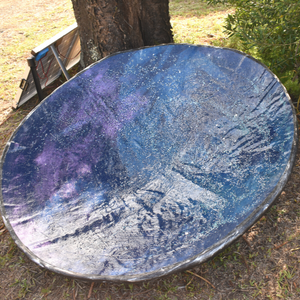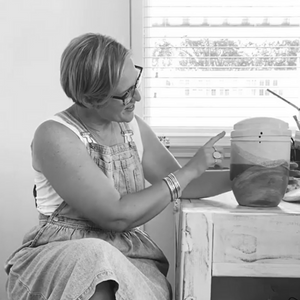Catching Fallen Stars (2020)
Fibre/cement composite and polyester fibreglass, polyester resin, glass embellishments, recycled satellite dish, acrylic paint, acrylic ink, LED lighting and solar panels

I invite you to look slowly
to spend time with the stars
to experience a natural reverie
and let your thoughts drift on the air.
I invite you to be still let the stars anchor you here.My slow art practice uses time as a raw material. Via laboured repetitive markmaking using tools of the present’s velocity, I enter a meditative place, drifting from physical awareness into a mindful, liminal space in contemplation of the night sky. This time focussed on nature has a slowing affect, achieving for me a sense of personal resonance about what it means to feel human in the world today.
About the Artist

Kristy Gordon is an emerging artist who lives on Darkinjung Country, in Central Coast NSW. She is a current PhD candidate at UNSW Art, Design and Architecture, where her research explores repetition and contemporary slowness. She has exhibited in solo and group shows across Sydney and the Central Coast and has been a finalist in several art awards, including the Gosford Art Prize 2020.
Transcription
Kristy Gordon, I'm an artist and a researcher at UNSW. I'm during my PhD in Slow Art. My artwork is called ' Catching Fallen Stars' and it's a work that pays attention to time, nature and our place as humans in the world. So for me, my artwork is a meditation on the night sky and I hope it encourages viewers to contemplate the night sky or at least have a moment of quiet reverie.
It's a large bowl. It's a large, shallow bowl, about one point seven meters across which I've hand formed out of a material called fibre cement composite, which works up a little bit like clay that cures as strong as concrete. The inside of the bowl is a fiberglass and polyester resin interior which I've tinted with pigments and then worked into with paint and more metallic pigment, glitter and mica I've then drilled hunt using the power tools, I've drilled hundreds of tiny little holes into the fiberglass surface.
These marks kind of mimic the stars at night. They emit their own light because internally, I've got a solar powered led system within the work. So in the low lights, like in low light, it will emit its own light, but in the bright, harsh sunlight, I've fixed the tiny mirrors to each hole so that the sunlight will catch.
The process of making and the experience of viewing, I hope have a relationship. So when I want to make work, I call it slow making, which to me is a process where I take time and time becomes a raw material. So the time the making, the use of time in making of the work is as critical as the fiberglass resin or the concrete composite. So when you're viewing the work, you know that it's a lot of time has been taken to make it and with that time comes reflections. So, in my process I work in in labour and repetition.
So the actions in this particular work, or a combination of like you know, these repetitive actions are either drawing, the drilling, the gluing of the tiny mirrors to the surface of the work, all of those detailed, focused moments, are moments of reflection for me as a maker. The, when, when you're making in this repetition you tend to fall into a bit of a rhythm, and when I'm making this rhythm, you stop thinking about what you're actually doing with your hands and you start you sort of it lends itself to a drifting mind. So I lose focus on the gesture and kind of move into a place of thinking more about the subject. In this particular case it was the stars in the night sky. But the contemplation itself can yet can also, it's just it's just a quiet and reflective space. So for me I reflect on nature and on the subject that I'm making the work about. But that's, that's right.
I think it has a good place at Rookwood, simply because it is a contemplative work. It is meant to make you. It's meant to encourage someone just to sit and look at it, to sit and look within and, maybe look into themselves, you know, in a reflective or a meditative way. My work invites visitors to do what's naturally done at Rookwood, which is to be still and to think. And so the two critical things in my work are reconnection with nature, or reclaiming value from nature, and also connection with the self through reverie. So in the speed of every day, like in the velocity of our present I feel like humans loose connection with nature and with each other and sometimes even ourselves.
So my work, which is made through the lens of slow philosophy, asks me and also, in turns the viewers, to be still and to connect with their own self and their own place in nature or in a moment in time away from that pace and the noise of life. So a cemetery being a natural it feels to me like a natural meeting point of these sorts of themes. So I think of the Rookwood Cemetery as a place of remembrance and I think it's also important to consider introspection in connection with self when you're in a place like that.